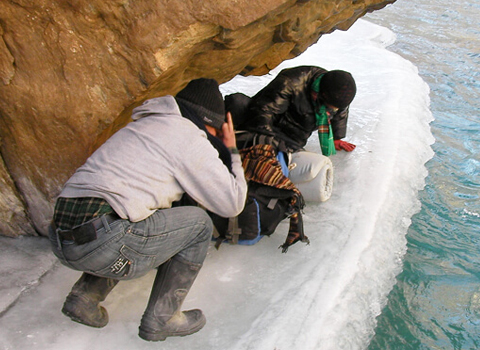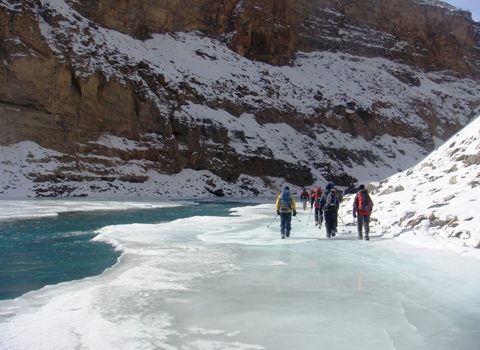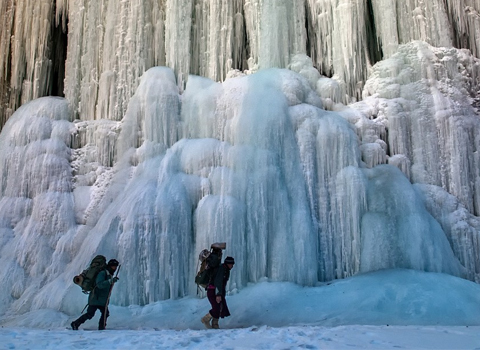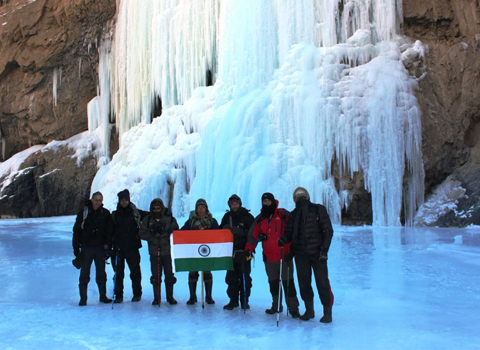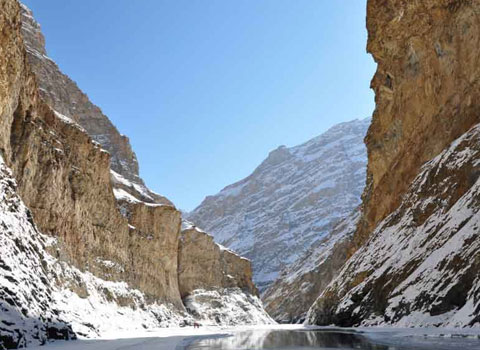Overview
Region: Leh,Ladakh,J&K
Duration: 9 Days/8Nights
Level: Difficult
Distance: 75kms Trekking
Altitude: 11,123ft
Pickup Point: Leh airport
Drop Point: Leh airport
Best Season: Mid January to Mid February
Base Camp: Chilling
Brief ITINERARY
Day-1
Report at Leh.
Acclimatize
Altitude 11,400 ft.
Overnight Stay in guest house.
Keep your woollen cap and gloves handy.
Day-2
Drive to Chilling-Trek to Tilat Sumdo camp
11,400 to 10,390 ft.
Drive 65 kms/3hrs+1 hr trekking
Stay in tent.
Day-3
Trek to Tsomo Paldar trek
10,390 to 10,550 ft.
Trek 10 kms/6 hrs.
Stay in tent
Day-4
Trek to Dibb Cave.
10,550 to 10,760 ft.
Trek 15 kms/8hrs
Stay in tent.
.
Day-5
Trek to Naerak Pullu
10,760 to 11,150 ft.
Trek 12.5 kms/7hrs
Stay in tent.
Attraction Frozen waterfall.
RETURN TREK
Day-6
Naerak to Tibb Cave.
11,150 to 10,760 ft.
Trek 12.5 kms.
Stay in tent
Day-7
Tibb Cave to Shingra Koma.
10,760 to 10,550 ft.
Trek 15 kms.
Stay in tent
Day-8
Shingra Koma to Tilad Do and drive to Leh.
10,550 to 10,390 and drive to 11400 ft.
Trek 10 kms.
Drive 65 kms.
Stay in guest house.
Your trek ends on Day 8.
Day-9
Return from Leh
About The Destination
The Chadar Trek or the Zanskar Gorge is a winter trail in the Zanskar region of Ladakh, in the Indian state of Jammu and Kashmir. Traditionally the only means of travel in the area during the harsh winter months, the trail has become popular with international adventure tourists.
"CHADAR" refers to the blanket or sheet as the Zanskar river transforms itself from a rapid river into a white blanket of ice during winter, a frozen spectacle awaits the trekker to be experienced of glass ice ranging from a bluish tinge to golden yellow that is seen during the few hours that sunlight reaches directly into the gorge to the milky whitish on a moonlit night - as said a trek journey like no other!
ZANSKAR: Zanskar valley lies to the south - west of Leh, surrounded by the Himalaya and Zanskar ranges, which is the most isolated of all the trans - Himalayan Valleys. Zanskar comprises of two main valleys the Stod(Doda Chu) and the Lanak (Tsarap Chu)which coverage below at Padum. The area remains inaccessible for nearly 7 months in the year. All passes close in the winter and the river freeze on the surface. Zanskaris walk along it to reach the Indus River in Nimoo (Chilling village), which is known as the Chadar (frozen blanket) Trek.
The geographical isolation has resulted in the preservation of the Buddhist heritage and identity. Many ancient monastic establishments are still actively involve in religious activities some remote caves are believed to have been used by the successive Buddhist saints to sustain meditation in pursuit of knowledge and enlightenment.
DETAILED ITIERNARY
Day 1 - Arrival at Leh
On arrival in the morning at Leh airport. Transfer to lodging at the guest house; a day of leisure and acclimatization. Overnight at Leh guest house.Day 2 - Leh to Chilling drive, and a short trek to Tilat Sumdo.
In the morning we leave by private vehicles with our support staff to begin this amazing and most exciting winter trek. Shortly after leaving Leh, we reach Nimoo, the confluence of Zanskar and Indus rivers. The sight is amazing as the iced up and frozen Zanskar meets the fast flowing Indus.
We stop here for around 5-10 mts for all to have a view and a click. We then turn down from Nimoo following the track parallel to the frozen River Zanskar, a drive towards the road head beside the frozen river is another amazing experience.
Travel distance between Leh and Chilling is around 64 KM. We reach now to the point, past the village of Chilling to where the roadhead ends. Touching the Chadar first time, we start the trek for 1-2 hrs along the magnificent frozen river Zanskar till Tilat Sumdo. Overnight in tent.
Day 3 -Trek to Tsomo Paldar.
Wake up time is around 7:00 am, freshen up. Breakfast with hot tea and you are ready for a day full of frozen ice river trek by 9:00 am.
Hearing the different sounds of Chadar forming and breaking, you will soon get familiar where the Chadar or the ice cover is thick and thin. With a early lunch break in between, we would soon reach the majestic. Lunch is in between the trek, where we all stop where sunlight is abundant though duration is much less as the river flows through a gorge and direct sunlight time is limited.
We trek again on frozen ice towards the designated camping site for the day. Overnight at camp
Day 4 - Tsomo Paldar – Dibb
Early in the morning after having our breakfast, it is an another day of ice t expedition among some of the most fantastic landscapes and ice vistas. Vast mountain sides rise up abruptly from the river as it flows through gorge. We might even catch sight of bharals or blue sheep as we trek along the frozen river. Not to say about the frozen waterfalls!
Though today is the longest day of the trek, we pass through some magnificent beautiful waterfalls and frozen ice cliffs on the left - it is like walking through a giant freezer! The walk also crosses through narrow gorges, where the trekker may have to climb briefly on to the rocky river bank.
We trek again on frozen ice towards the designated camping site for the day. Overnight at camp
The sharp bends and current of the river breaks the ice in some places. Lunch in between on a flat rocky hill side by the river. Overnight at camp
Day 5 - Trek from Dibb to Nyerak Pullu
Again one of the magnificent days on the Chadar trek. However, the caution being that this can become a difficult if the Chadar is not very firm. The vistas are stunning though as we pass through giant frozen waterfalls, ice cliffs and one may even catch sight of the mountain fox.
After lunch we pass the 'incense tree', so called because the locals use its branches to burn in their morning rituals, and the prayer flag draped tree marks the entrance to Zanskar proper. The porters will normally take a few twigs from the tree. We reach Naerak campsite by late afternoon. An old, dilapitated bridge on the river as folklore goes is thought to be more than an 1000 years old. A trail is normally beaten through in the snow towards the village up high in the mountains. Overnight at camps.
Day 6 - Naerak – Dibb:
Though technically it is the same way back, it is also quite different. The Chadar or the blanket of ice that is forming on the River Zanskar is always changing, breaking up and forming itself again. As the Chadar dynamics are ever changing, the same route and place would look and feel different as the texture and conditions change.
All along the way, trekkers will pass by and meet a lot of locals wearing their traditional woolen Gonchas, trekking their way towards the village of Padum, Lingshed and Naerak. Pleasantries are exchanged and even a few stories and legend about Zanskar and its people can be heard. Their warmth and smile is amazing among all the hardships. Overnight at camp.
Day 7 - Trek from Tibb to Shingra Koma:
Day 8 - Trek from Shingra Koma to Tilat Do, and drive to Leh.
Today is the last day of this amazing and unique trek. We finally return back to the road head where our vehicle will be waiting to take us back to our guest house at Leh.
A huge goodbye to the support staff; their absolute dedication and support is nothing short of amazing. Finally on reaching at Leh, the guest house room of Leh after some 8 days is most welcome, yet the experiences of this ice trek linger and will be remembered forever. Overnight at guest house in Leh.
Your trek ends on Day 8 after reaching Leh
Day 8 - Return from Leh by early morning flight.
So finally a goodbye and good wishes for your return flight to Leh as you board the early flight back to your home town, and definitely some great memories and a lifetime of an experience to narrate to many a friend and family.
Cost Terms
COSTS INCLUDES
*Accommodation: Stay at Leh Hotel/Guest House on Day 1 and Day 8 of Trek and tents/camps on the trek.
*Transportation from Leh to the road head at Chilling from where the trek starts.
*Vegetarian meal during the trek
*Sleeping bags and mats.
*Trek leader, Porters, helpers and Cook.
*Services of an Qualified and experienced Trek Leader to guide over the entire tour.
COSTS EXCLUDES
*Food/Meal in Leh.
*The newly proposed Wildlife Fees and Envoirmental fees as being put forward by LAHDC and ALTOA. The rate for 2018 Chadar Trek is still to be announced, though provisionally it has been decided at Rs 2300 for Indian nationalities and Rs 2800 for foreign tourists. Again, it has not been confirmed yet. Clients are required to pay the permits/fee there itself.
*Personal expenses and tips.
*Personal winter and trek requirements like jackets, sun glasses, gloves, and trekking poles.
*Anything not specifically mentioned under the included list.
*Cost incidental to any change in the itinerary/ stay on account of flight cancellation due to bad weather, ill health, roadblocks and/or any factors beyond control.
Note: Common gear is carried by the porters and helpers. All trekkers are required to carry their own backpacks along with their personal belongings. IF for some reason the trekker is unable, then he/she can give to a porter and pay a daily service fee to the porter as required, normally in the range of Rs 700/- per day per bag.
Trekkers who are confirmed would be required to carry the following documents.
An identification card (like driving license, voters ID card etc), along with a photocopy.
A passport size photo.
In addition all participants are advised to submit to us upon arrival, an appropriate medical fitness certificate obtained from a registered medical practitioner in the country of their origin indicating that the individual is fit to go on a high altitude trek, and that he/she has no physical and medical disabilities that would limit him/her from trekking. (The form will be mailed to clients)
These documents are mandatory. Without them you will not be allowed to trek.
Drop out during trek:
While on the trek, if for some reason a participant has to drop out on any day (Eg, tiredness, fatigue or symptoms of altitude, etc) then Himveer Tour & Trek wiil make arrangements for his/her return to the nearest road head. After a participant returns to the road head/village any further transportation or stay cost has to be borne by the participant. On the Chadar trek it is at Tilat Do/Chilling. From Chilling you get vehicles to Leh. Vehicles are intermittent and may take a while to get and could involve stay at Chilling. In case of dropping out of the Chadar trek, transportation and stay cost at any location including Leh has to be borne by the participant.
Emergency on a trek:
If there is a medical emergency on the trek, your trek leaders are trained to handle crisis and rescue. Himveer Tour & Trek team will carry a basic first aid kit. Most situations are resolved by the trek leader and the helpers and porters. If, however, evacuation is required, it is carried out by Himveer Tour & Trek team. The affected participant is moved down to the nearest emergency medical centre as soon as possible. Medical expenses, if required, at the medical centre are to be borne by the participant.
On camp/trek regulations
1. During the camps or treks, the participants shall abide by the instructions and decisions of the Zanksar Trek leader and guide.
2. During the camps or treks, in case of any dispute for whatsoever reasons, the decision of the Trek leader shall be final and binding on all the participants.
3. In the event that the participant(s) disobey the directions / instructions of the Trek Leader, the participant(s) shall be solely liable for the risks, responsibilities and consequences.
4. In case of any medical problems, ailments, disorders etc. or symptoms of the same, arising during the camp or trek, the participant(s) shall inform the organisers about the same, at the earliest.
5. If required, the participant(s) will have to take medical treatment from the doctor/attendant available on the campsite or from the nearest available medical centre or hospital. The expenses for all medical treatment and arrangements for the same will be solely borne by the participant.
6. The Trek Leader or the authorised representative shall have complete discretion to continue the camp without the participant(s) suffering from medical problem.
7. Consumption of liquor, tobacco products, cigarette etc. is strictly prohibited during the camp or trek. The trek will be considered over only when we are back to home town.
8. Each trekker shall protect the flora and fauna of the place being visited and not throw plastic, wrappers etc. on the trek.
9. Participants should not deface or damage any monument by writing or scribbling on them. Any flouting of the above two rules will be dealt with seriously, and may involve expulsion from the trek or camp, and no refund is admissible in such cases.
10. In case of any injury, sickness, accident, death or any other casualty or loss or damage of valuables or luggage or any equipment; Big Planet, it's instructors, organisers, volunteers or any other person involved wholly or partially, either individually or jointly, shall not be responsible in any manner for the same and no claims of the participants, parents, guardians, relatives or friends of participants will be entertained.
Chadar Frozen River Trek Frequently Asked Questions
Q. When is the best time to go to Chadar Trek?One of the most unique and magnificent treks of the world, Chadar Trek is huge popular now. Chadar or cover, signifies the frozen sheet of ice that is formed on the raging River Zanskar due to extreme coldness as well as due to the less amount of direct sunlight as the river flows through a narrow gorge. Solid ice is best around the time the Chadar trek takes place, from 2nd week of January to 2nd week of February - the time when the coldness is at it maximum during the winte rmonths, hence this time frame is the best time for this Zanskar River trek.
Chadar Trek is the only route available to the villagers in the Padum and Lingshed region to go to Leh and back. Regular up-downs are done by the locals to earn their wages. The trek itself is the quintessential example of the resourcefulness and the indomitable spirit of the Ladakhi people. Though, the trek will soon cease to be the sole mode of access between Leh and Padum in winters. A road is being constructed by blasting off the rock-face above the river. It will be a much safer and convenient route for the locals, but surely mark the end of an ancient local custom.
Q. What is the level of difficulty of Chadar trek?
If you can walk on an average of 5 to 6km without a problem, then you can! As such any one with good average fitness can do this trek and any kind of exercise which gets you fitter before this trip is advisable, as it will enable you to enjoy the region more. Overall chadar trek is a moderate trek but temperature wise it is cold, though after the first couple of nights on the Chadar, trekkers are much more adjusted to the bitter cold!
Q.How cold does it really get on the Chadar trek?
During the day time temperature will be -5 to -10 degrees and during the night time -20 to -25 degrees. While on the trek, the activity itself gives the body some warmth.
Q. What kind of attire do I wear to endure the extreme Chadar Trek winter cold?
Wearing clothes in layers is much effective is combating the bitter cold, particularly at night.
Layer 1 - Starting with inner thermals
Layer 2 - full sleeves t-shirt and track pants; Woollen Socks (One double woven woollen socks with one warm nylon or normal woollen socks inside). Carry enough spare socks and other undergarments.
Layer 3- Fleece Jacket. Good thick Woollen Monkey Cap or Balaclava with woollen Muffler
Layer 4 - Wind Proof / Water Proof Jacket
Layer 5 - A jacket or another layer of inner thermals. Two Pair of gloves (Thin Woollen inside and outside Wind Proof / Waterproof Snow Gloves). Good Pair of Sun Glasses with Good UV Protection.
Wearing in layers also helps to remove one or two layers as you feel warm due to the activity of trekking; similarly while going off to sleep in the sleeping bag, a few layers can be removed if feeling uncomfortable. Avoid cotton T shirts.
Pack similar things such as clothes or toiletries or others in separate polythene bags so they are easier to find and pull out. Trekking pole is absolutely desirable as it greatly helps during the Chadar trek.
Q. How long do we walk each day?
A day on a trek begins with breakfast at 7 am by which time; you are expected to vacate your tent so packing can begin. We aim to usually be on the trail by 8:30 am and reach our camp for the day by 2-3pm, if not earlier. Long days on the trail may mean an earlier start and 8-10 hour walking day. Lunch is usually had on the walk, and you'd get into the kitchen tent for a welcome cup of tea.
Q. Who will lead and who all will go along with us?
Our entire crew will consist of very expereienced Zanskari guide and cooking staff (along with Zanskari porters), which would prepare the meals for the days and nights that we are camping out. The entire crew moves together in a totally self-contained manner like a tight knit unit. Some of the porters will go ahead forward and set up the camps and the kitchen tent, before the trekkers reach the designated camping area for that day.
*Benefits of employing Zanskaris and local Ladakhis?
Employ Guides with intimate knowledge of the areas you want to visit. This is especially important for trekking off-the-beaten-track and winter trekking on the Zanskar River.
The direct employment of Zanskaris and Ladakhis will benefit the local economy.
A greater chance of experiencing and understanding Zanskar's traditions, cultural heritage and contemporary issues. Your visit to Zanskar becomes more than just a walk or trek.
*Important Note: Your safety is of paramount concern while travelling with Himveer Tour & Trek. Please note that your leader has the authority to amend or cancel any part of the itinerary if it is deemed necessary due to safety concerns. Every effort will be made to keep to the above itinerary; however, since this adventure entails travelling in remote mountainous regions, we cannot guarantee that we will not deviate from it. Weather conditions, health condition of a group member, unexpected natural disasters, etc., can all contribute to changes in the itinerary. The leader will try to ensure that the trip runs according to plan, but please be prepared to be flexible if required.
Q. How big are the groups?
Groups range from 6 to 15 people in one batch and includes both males and female. Be assured, service and coordination remains effortless whatever be the size of the group.
Q. I am the only girl in trek, is it safe?
Absolutely. Normally all trek groups have both males and females. If you are the single girl in a batch, single tent accommodation will be provided at no extra cost.
Q. I can't carry my bag can anyone carry it for me?
Yes, But you should intimate in 15 days in advance, so that we will arrange porter accordingly on chargeable basis.
Q. Which type of shoes should I have?
Good standard trekking shoes are sufficient for the trek. On Chadar, which is solid ice or a slight cover of snow on slippery ice, trekkers have found to their amazement that a simple gumboot finally is the best for Chadar. Most of the outside agencies in order to impress tell about crampons. In my years of experience in Ladakh and on Chadar too, I can absolutely say that crampons are quite dicey - quite a few trekkers have injured themselves or worse broken their ankle while a crampon get stuck on the fine cracks in the ice. Gumboot is available in Leh hardware shop and can be purchased here itself. If your shoe size is 9-10, getting a pair might be tough..so start searching as soon as you land in Leh.
Trekkers will soon learn and modify their trek to the "penguin walk" style on seeing from the porters and guide! It is a kind of dragging your foot and not lifting much.
Q. How many trekkers will be in one tent?
Two or three trekkers in one tent.
Q. What type of food is served during a trek?
We always serve Indian vegetarian food and eggs during our trek.
Q. How to get safe drinking water on the trek?
Himalayan water is consider as a clean and mineral water but for safe side we use boil water and chlorine tablet in our camps, during the trek ask once to trek leader or guide from where to fill water bottles. It is important to keep sipping on water through the trek as one can get dehydrated and still not feel it due to the cold.
Q. Do you think I should bring some medicines with me?
Yes, absolutely. It will help for you all to carry some easy to access medicine on the trip, for headaches, diarrhoea, constipation, and some rehydration powders like Electoral etc. It's also a good idea to have a roll of toilet paper accessible should you need to go.
Travel to any part of the Indian Himalayas and more so in Ladakh deserves a little more respect than many other high altitude destinations because the most of the regions lie over 3500 meters (11000+ ft). People in good health should not get alarmed by this but if you have a medical condition such as high blood pressure, heart or lung disease, you must take the advice of a doctor who has experience with the effects of altitude.
TheMedical Certificate and the Release of Liability forms, is mandatory for the trek participants. If you are not able to get the medical certificate, you would have to sign a self-declaration risk declaration i.e., basically a form that states that the participant is going on his/her own risk. The risk declaration form will be available in Leh. .
Q. Change of the itinerary during trek?
Depending on the prevailing situation, however the date of trek completion should always coincide with the original itinerary. You should keep in mind that this is an adventure trip into the remotest region, where many unforeseen events may contribute to the need for a change in itinerary. In such cases, we or your trek leader will suggest the best alternative similar to your original itinerary.
Q. Cutomization of trip?
Yes, if you would like to travel independently, you are invited to choose any of the trips at your convenient time frame for any number of people. Cost for private trip is fixed on the basis of group size, trek area, duration and trek style.
Q. Why is the trek costly?
a) You have only one option to reach Leh during winter, i.e. fly to and fro all other route are blocked due to extreme winter.
b) Expensive labour, Porter rates are more than double in the bitter cold and harsh winter months.
c) All food has to be flown in so obviously is very expensive.
d) Fuel since limited is expensive, it takes almost twice the amount of fuel to cook the food than in normal conditions.
e) Everything is paid for and arranged more than a month before the trek season due to scarcity of material and men during those two extreme cold months. As such the trek fee is collected before the actual trek date.
How to Reach
Himveer Tour & Trek GUIDELINES
DO’S AND DON’TS ON A TREK
1.Alcohols or any other intoxicating products "STRICTLY PROHIBHITED" during the trek.
2.Always pay heed to the trek guides or instructors.
3.Try not to leave the group under any circumstances.
4.Avoid trekking during the nights as it is extremely dangerous.
5.Avoid using earphones as that might hinder your hearing.
6.Do not participate or encourage littering of the places in any form.
7.While visiting the local villages and tourist sites, obey the local guidelines and instructions.
8.Do not harm or interrupt the local sentiments of the places.
IMPORTANT:
Your safety is of paramount concern while travelling with Himveer Tour & Trek.
Please note that your leader has the authority to amend or cancel any part of
the itinerary if it is deemed necessary due to safety concerns.
Since adventure entails travelling in remote mountainous regions, we cannot guarantee that we will not deviate from it. Weather conditions, health condition of a group
member, unexpected natural disasters, etc., can all contribute to changes in the itinerary. The leader will try to ensure that the trip runs according to plan, but please be prepared to be flexible if required
Fixed Departure 2018
Mid January To Mid February
JANUARY: 7,14,21,22,27
FEBRUARY: 4, 12
Himveer Tour & Trek Importants Links
Himveer Tour & Trek Basic trek Gear Checklist for client
A) A good quality rubber sole with mid sole and ankle support (Medium or high ankle) shoe. Click here
Himveer Tour & Trek Medical Form For Thr Client
Himveer Tour & Trek treks organised by SHRIDHANT EXPEDITIONS (OPC) PVT LTD. take place in some remote and less-developed regions, without means of rapid evacuation, Click here
Frequently asked questions(FAQs)
Here are answers to a list of generic questions which are asked to us on any treks. We have tried to answer most of them and this list of questions keeps growing with time. If you still have doubts, Contact Us us over phone or email to clear your doubts. We will be happy to help !!
Toilets On Trek: There will be a separate toilet tents. For a bigger group ( more than 8 trekkers ), separate toilet tents for men and women will be provided to keep up with the timings. The toilets will be a dry toilet where a pit will be dug and will contain a hump of mud outside. You can use wet tissue papers. After you finish your business, you need to cover the dump with the mud outside. A small shovel will be kept for the purpose. You should not use water in the toilet pit. When we shift camps, we will ensure that the pit is well covered and the area is clean. For tea house treks, toilets are well maintained by the owners.
We would be carrying all of the camping and technical equipment and the cost of it will be included in the package price. If you had requested a customized trek package, this will depend on what you have asked for.
For a detailed generic list of what to carry on a trek, follow the link click here






